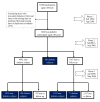Lipid ratios and appropriate cut off values for prediction of diabetes: a cohort of Iranian men and women
- PMID: 20712907
- PMCID: PMC2933665
- DOI: 10.1186/1476-511X-9-85
Lipid ratios and appropriate cut off values for prediction of diabetes: a cohort of Iranian men and women
Abstract
Background: Dyslipidemia is a risk factor for incident type 2 diabetes; however, no study has specifically assessed the lipid ratios (i.e. total cholesterol (TC)/high density lipoprotein cholesterol (HDL-C) and triglyceride (TG)/HDL-C) as predictors of diabetes. We aimed to compare the independent association between the different lipid measures with incident diabetes over a median follow up of 6.4 years in Iranian men and women.
Method: The study population consisted of 5201 non diabetic (men = 2173, women = 3028) subjects, aged > or =20 years. The risk factor adjusted odds ratios (ORs) for diabetes were calculated for every 1 standard deviation (SD) change in TC, log-transformed TG, HDL-C, non-HDL-C, TC/HDL-C and log-transformed TG/HDL-C using multivariate logistic regression analysis. Receiver operator characteristic (ROC) curve analysis was used to define the points of the maximum sum of sensitivity and specificity (MAXss) of each lipid measure as a predictor of diabetes.
Result: We found 366 (146 men and 220 women) new diabetes cases during follow-up. The risk-factor-adjusted ORs for a 1 SD increase in TG, TC/HDL-C and TG/HDL-C were 1.23, 1.27 and 1.25 in men; the corresponding risks in females were 1.36, 1.14, 1.39 respectively (all p < 0.05, except TC/HDL-C in females which was marginally significant, p = 0.07). A 1 SD increase of HDL-C only in women decreased the risk of diabetes by 25% [0.75(0.64-0.89)]. In both genders, there was no difference in the discriminatory power of different lipid measures to predict incident diabetes in the risk factor adjusted models (ROC approximately 82%). TG cutoff values of 1.98 and 1.66 mmol/l; TG/HDL-C cutoff values of 4.7 and 3.7, in men and women, respectively, TC/HDL-C cutoff value of 5.3 in both genders and HDL-C cutoff value of 1.18 mmol/l in women yielded the MAXss for defining the incidence of diabetes.
Conclusion: TC/HDL-C and TG/HDL-C showed similar performance for diabetes prediction in men population however; among women TG/HDL-C highlighted higher risk than did TC/HDL-C, although there was no difference in discriminatory power. Importantly, HDL-C had a protective effect for incident diabetes only among women.
Figures
Similar articles
-
Lipid measures for prediction of incident cardiovascular disease in diabetic and non-diabetic adults: results of the 8.6 years follow-up of a population based cohort study.Lipids Health Dis. 2010 Jan 23;9:6. doi: 10.1186/1476-511X-9-6. Lipids Health Dis. 2010. PMID: 20096127 Free PMC article.
-
Associations between non-traditional lipid measures and risk for type 2 diabetes mellitus in a Chinese community population: a cross-sectional study.Lipids Health Dis. 2016 Apr 5;15:70. doi: 10.1186/s12944-016-0239-y. Lipids Health Dis. 2016. PMID: 27044245 Free PMC article.
-
Utility of serum lipid ratios for predicting incident type 2 diabetes: the Isfahan Diabetes Prevention Study.Diabetes Metab Res Rev. 2016 Sep;32(6):572-80. doi: 10.1002/dmrr.2770. Epub 2016 Jan 26. Diabetes Metab Res Rev. 2016. PMID: 26663847
-
Serum Lipids During 20 Years in the Tehran Lipid and Glucose Study: Prevalence, Trends and Impact on Non-Communicable Diseases.Int J Endocrinol Metab. 2018 Oct 16;16(4 Suppl):e84750. doi: 10.5812/ijem.84750. eCollection 2018 Oct. Int J Endocrinol Metab. 2018. PMID: 30584435 Free PMC article. Review.
-
Optimum lipid testing for diabetic patients to enhance clinical care.Diabetes Metab Syndr. 2021 Jan-Feb;15(1):461-464. doi: 10.1016/j.dsx.2021.02.004. Epub 2021 Feb 9. Diabetes Metab Syndr. 2021. PMID: 33607521 Review.
Cited by
-
Elevated triglyceride/high-density lipoprotein-cholesterol ratio as a risk factor for progression to prediabetes: a 5-year retrospective cohort study in Japan.J Diabetes Metab Disord. 2023 Oct 25;23(1):655-664. doi: 10.1007/s40200-023-01329-8. eCollection 2024 Jun. J Diabetes Metab Disord. 2023. PMID: 38932848 Free PMC article.
-
Association between triglyceride to high-density lipoprotein cholesterol ratio and type 2 diabetes risk in Japanese.Sci Rep. 2023 Mar 6;13(1):3719. doi: 10.1038/s41598-022-25585-5. Sci Rep. 2023. PMID: 36878958 Free PMC article.
-
Data-driven phenomapping for novel classification for cardiovascular outcomes compared with traditional obesity index: Tehran Lipid and Glucose Study.BMJ Open. 2023 Jun 14;13(6):e071011. doi: 10.1136/bmjopen-2022-071011. BMJ Open. 2023. PMID: 37316323 Free PMC article.
-
Association between the ratio of triglyceride to high-density lipoprotein cholesterol and incident type 2 diabetes in Singapore Chinese men and women.J Diabetes. 2017 Jul;9(7):689-698. doi: 10.1111/1753-0407.12477. Epub 2016 Oct 7. J Diabetes. 2017. PMID: 27573855 Free PMC article.
-
Relationship of oxidized low density lipoprotein with lipid profile and oxidative stress markers in healthy young adults: a translational study.Lipids Health Dis. 2011 Apr 19;10:61. doi: 10.1186/1476-511X-10-61. Lipids Health Dis. 2011. PMID: 21504598 Free PMC article.
References
-
- Saadi H, Carruthers SG, Nagelkerke N, Al-Maskari F, Afandi B, Reed R, Lukic M, Nicholls MG, Kazam E, Algawi K, Al-Kaabi J, Leduc C, Sabri S, El-Sadig M, Elkhumaidi S, Agarwal M, Benedict S. Prevalence of diabetes mellitus and its complications in a population-based sample in Al Ain, United Arab Emirates. Diabetes Res Clin Pract. 2007;78:369–377. doi: 10.1016/j.diabres.2007.04.008. - DOI - PubMed
Publication types
MeSH terms
Substances
LinkOut - more resources
Full Text Sources
Medical
Miscellaneous


